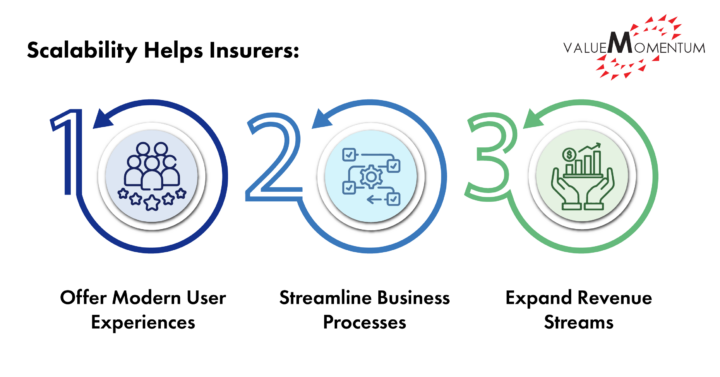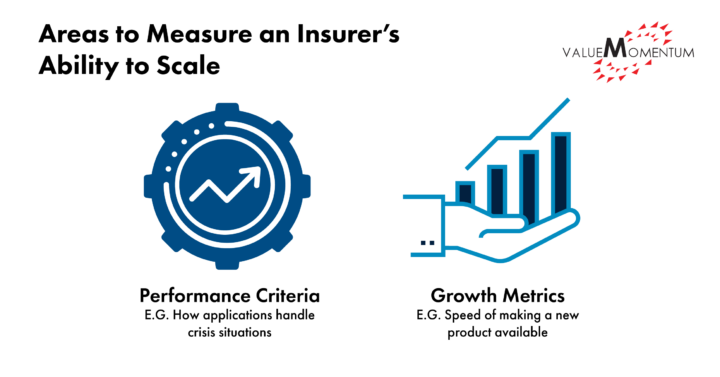To keep up with competitors, insurers must offer modern front-end user experiences while delivering consistent, rapid service and innovative products. They must also collaborate effectively with a range of MGAs, brokers, and aggregators to expand their products’ reach in the marketplace. How exactly does an insurer accomplish all of that through their applications? The solution lies in focusing on scalability in their approach to application engineering.

Scalability is closely linked to insurers’ top business challenges. Insurers want to offer customers, agents, partners, and employees that modern user experience. But they also want to optimize their business — whether that means streamlined underwriting, claims submission, or policy administration — and they want to increase their revenue, often by launching new products and expanding into new geographic areas.
Scale requires a more holistic approach than just an accelerated product configuration in an insurer’s core system. When it comes to application scalability, there are two critical abilities to consider:
- The ability to support more users, traffic, and workloads
- The ability to support new products, feature extensions, and geo-expansion
This means that an insurer’s ability to scale should be measured both by performance criteria, such as how well its applications can handle a crisis situation, and by growth metrics such as how fast an insurer can make a new product available across all of its distribution channels.

Enabling Scalability With Application Engineering
Insurers can engineer an application infrastructure that considers all facets of scalability by leveraging a configuration-driven framework. This type of framework helps developers focus on the functional implementation of applications while ensuring that a carrier can build new applications easily whenever they need to, whether they are launching a new product and need a new customer portal or have recently undergone a merger and need to consolidate two rating applications.
When a developer starts off building a new application, they have to take into consideration:
- Business requirements
- Non-functional requirements
- Organizational and industry standards and guidelines
- Workflow
- Auditing
- Compliance
- Exception handling
- Logging
- Performance
Taking a configuration-driven approach to application engineering means developing all of those considerations according to organizational needs and standards once, then incorporating those baseline enterprise standards into templates and frameworks that can then be configured to meet future needs.
For example, whether an insurer’s IT team is launching new engagement channels, adding a new set of rating models into their policy workflow, onboarding new underwriting rules or forms, or changing how adjusters examine claims information, configurable templates and frameworks can help efficiently launch new applications or integration layers and effectively incorporate feature extensions into an insurer’s workflow.
Building an application that is consistent with the rest of the organization without having to develop it entirely from scratch is in line with the industry’s shift toward low-code and no-code solutions, ensuring that developers aren’t stuck dealing with code unnecessarily when they could simply be configuring applications to achieve the organization’s business goals.
Applying a Configuration-Driven Application Engineering Approach
ValueMomentum recently worked with a specialty insurer that was looking to increase the ease with which it could scale its specialty business. Not only was the insurer hoping to improve application performance as traffic for its specialty products increased, but it was also looking to improve how fast it could launch new products and features, enhance its agent and customer experience, and optimize its integrations with distribution partners.
After a discovery phase to analyze the application ecosystem, ValueMomentum helped the insurer’s developers leverage application templates, which the developers configured to create new engagement and quoting applications rather than code each application from start to finish. The insurer’s IT team also leveraged an API domain reference solution that enabled partner-specific customization across the integration layer.
Using this configuration-driven approach allowed the developers to focus on the actual functionality rather than spending time setting up the boiler plate code aligning to compliance and logging considerations. In addition, the templates had observability built into each application so the carrier could track pre-determined KPIs for each application by effectively collecting application- and business-specific metrics to ensure that performance was meeting organizational standards.
The insurer can analyze and visualize these KPIs at various levels to help it make more strategic decisions. While business metrics like how many quotes an application is logging or how much time underwriting is spending on submission review are often handled at the enterprise level, they haven’t always been available at the application level.
Engineering a Path Toward Scalability
By customizing the level of application engineering they need once and then using it as part of a configurable template, insurers can make sure their applications and integrations are uniform; meet organizational standards; and include in-app dashboards that can log, monitor, and analyze application performance.
Standardizing and monitoring applications at this level can help insurers stay aware of areas to troubleshoot and monitor as well as immediately see any alerts for application performance to speed up operations and maintenance. In addition to performance, however, using a configurable approach to application engineering helps insurers launch new features, products, and applications at the rate needed to keep up with their business goals.
While performance is a critical function of any application, the true test of a successful application is its ability to evolve to meet business needs. Using a configuration-driven framework for application engineering that includes automation can help insurers bake scalability into their applications’ functional implementations and infrastructure from the very beginning, increasing speed, agility, and observability.
To learn more about how we can help your team customize its application engineering efforts for maximum growth, check out our App Development services.
